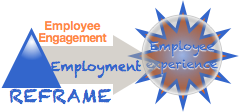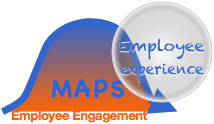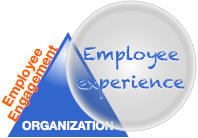![]() The Employee Engagement Fallacy reveals that most literature, papers, and methods are built on faulty Industrial Economy employment attitudes, and it provides an approach that uses experiential social media to help reframe employment and performance.
The Employee Engagement Fallacy reveals that most literature, papers, and methods are built on faulty Industrial Economy employment attitudes, and it provides an approach that uses experiential social media to help reframe employment and performance.
Although the idea of “employee engagement” can be a rare opportunity to increase competitiveness, its practice is compromised by well intended but flawed logic.
Here’s the fallacy: Employee “engagement” is the result of employees’ experiences while they’re working at employers. Few engagement programs focus on employees’ experiences, so they fall short.
Engagement is not achieved by a program or initiative that focuses on the outcome. Employers see much more success at achieving the result when they focus on empowering the experiences their employees want when they decide to work at the employer. Experience is the motor of engagement, so empowering experience is the first step of raising productivity and lowering employment costs, two common employee engagement goals. Here’s how it’s done.
Reframing Employment for Success in the Knowledge Economy
 Most organizations don’t realize that “employment” needs reframing to sync with the experience-based Knowledge Economy. Most employment attitudes, policies, structures, and programs are built on Industrial Economy principles whose time has passed.
Most organizations don’t realize that “employment” needs reframing to sync with the experience-based Knowledge Economy. Most employment attitudes, policies, structures, and programs are built on Industrial Economy principles whose time has passed.
To borrow a page from today’s most loved products, today’s most successful designers and marketers do not try to engage people with their brands or products (the Industrial Economy way). They discover and focus relentlessly on the outcomes their customers want when their products and services have the highest impact.
Put another way, they engage around holes, not drills. The drill is a necessary tool to get holes. No one wants an iPod; people want an easy way to listen to their music anywhere. Today’s Knowledge Economy differentiates on people’s experiences, and products and services serve as enablers to experiences. Clayton Christensen popularized a related concept, “jobs-to-be-done,” in The Innovator’s Solution. He asserts that customers “hire” products to do “jobs.”
As with customers and products, so with employees and jobs. The highest performing Knowledge Economy employees are mobile, and they evaluate each opportunity in terms of how it will help them address a cause and strengthen their skills and relationships (outcomes) as much as the pay and other traditional necessities.
Employers who are serious about outperforming in their markets need to create a culture and environment in which employees can do their best work, in which “work” engages employees’ emotions and creativity as well as their intellect and industry. To do this consistently, employers reframe “work” for the experience-based Knowledge Economy. They develop a very clear picture for how they can empower the outcomes their best employees want when they choose employers, and they structure job roles to support those outcomes. They become “career empowerment platforms.” Consequently, they earn breakthrough energy, passion, innovation, and productivity from their employees, and their relationships pre-date employment and continue long afterward.
Examples of Employee Outcomes
- An experienced cloud-based productivity software engineer with a recent MBA has a breakthrough idea for a smart car application, but he seeks automotive software experience before building his company. He’s hiring the automaker to build his automotive experience and network.
- An enterprise software project manager seeks a mid-level job at a startup to transition to lean/agile software development. She’s hiring the startup to retool her experience with the SDLC.
- A volunteer at a global service club becomes a member in the desire to line up his elementary aged children with global volunteering opportunities. He’s hiring the club to help make their college applications more competitive.
- A serial CFO of several software startups takes a huge pay cut to lead finance at a social enterprise that makes affordable wholesome food for school children from underprivileged families. She’s hiring the social enterprise to help her create social meaning and relevance in her middle age.
Notice that there’s a cause behind the employment in these examples, which come from people in my network. The point is, most motivated Knowledge Economy employees aren’t just “punching the clock” as in the Industrial Economy. When employers dial into and support the causes behind their employees’ employment, they transform their relationships with employees, which opens a new level of productivity.
From Employee Engagement to Employee Experience
Most employee engagement service offerings and case studies I’ve seen rely on a combination of branding, management coaching, recognition, and benefits. They try to produce the outcome, which is well intentioned but superficial compared to empowering employees’ outcomes. When employees have consistently exceptional experiences in terms of their career outcomes, breakthrough “engagement” consistently results.
Step One: Develop Employees’ View with Experience Maps
 Start by developing low fidelity (“straw man”) employee experience maps for your most valuable employees. Maps use research results to show major touchpoints, or interactions, an employee has during his/her career, and they show employee outcomes, so each touchpoint (job, school) is appreciated within the overall context. Most firms don’t understand the meaning of employment for their employees, and the experience maps are revelations because they provide the whole picture and each part in context. Here’s a quick and easy way to get started on the low fidelity maps. I use a similar approach when I conduct ethnographic research on employee behavior:
Start by developing low fidelity (“straw man”) employee experience maps for your most valuable employees. Maps use research results to show major touchpoints, or interactions, an employee has during his/her career, and they show employee outcomes, so each touchpoint (job, school) is appreciated within the overall context. Most firms don’t understand the meaning of employment for their employees, and the experience maps are revelations because they provide the whole picture and each part in context. Here’s a quick and easy way to get started on the low fidelity maps. I use a similar approach when I conduct ethnographic research on employee behavior:
- Since “most valuable” can be subjective, try using a metric like the highest per capita recruiting costs for 6 types of employees that impact your business (why you pay high recruiting costs).
- Start your ethnographic research by pulling recent job descriptions, which provide keywords. They are usually more useful than job titles, which are usually designed for the organization and vary with different firms. There’s no formula here; experiment and use what works.
- Use the keywords to search LinkedIn for people who are currently in roles with these keywords. Then time-box search results in two other time slices, so you analyze people who had similar roles three years ago, six years ago, etc. That will give you three time slices. Three is good, this is only the straw man, but set the intervals as makes sense. Analyze the career paths for patterns in terms of “success,” which is a combination of many factors, but use objective data like career progress, and sentiment. “Progress” is subjective, too. Increasingly employees dream more of starting their own companies more than being CxO, a big change from the Industrial Economy.
- Analyze the LinkedIn descriptions and recommendations for sentiment, and extend the analysis to employees’ other social media accounts, which will help you fine-tune attitude and sentiment.
- Test your emerging model by analyzing employees’ reviews on Glassdoor, Indeed.com, and other employer review sites. Then survey interactions on forums and blogs, where the deepest discussions are.
- At this point, you will have several rough employee experience maps that have been validated by digital social data of hundreds of employees. Of the six, 3-4 should have significant data and links; usually 1-3 won’t show enough public data to be interesting.
- Now go deeper by holding workshops to engage current employees with the rough maps—and your alumni who left three and six years ago. Present the low-fidelity maps on flipcharts, hand-drawn, because those are more engaging than digitally produced versions. During the workshops, co-create the higher fidelity employee experience maps with participants.
Please note: many organizations have had various types of job/career maps for years; the employee experience maps are different because they’re holistic—they put the employee at the center for most of his/her career—so they represent unprecedented scope and insight for most firms.
Step Two: Look at Your Organization From Employees’ Perspectives
 For the first time, you have example employees’ experience maps, so you can appreciate their aspirations and how their current “jobs” meet their aspirations. Now you have an opportunity to look at your organization from your employees’ perspectives. The maps will help you discover where these employees encounter frustration, and you’ll be able to respond by tweaking roles, policies, management styles, and other things to reduce churn. That’s a powerful intermediate outcome.
For the first time, you have example employees’ experience maps, so you can appreciate their aspirations and how their current “jobs” meet their aspirations. Now you have an opportunity to look at your organization from your employees’ perspectives. The maps will help you discover where these employees encounter frustration, and you’ll be able to respond by tweaking roles, policies, management styles, and other things to reduce churn. That’s a powerful intermediate outcome.
Each organization is so different that it’s difficult to generalize, but here are some good practices:
- One of the biggest challenges is detoxing from having drunk your own kool-aid for many years. All human groups and organizations drink their own kool-aid. A good hack for this is to include a large contingent of recent hires on your team, and create a team environment that encourages opinions and respectful discord. The kool-aid affects your efforts because most firms believe they already please employees. A good test for this is management’s attitudes toward employee review sites. Recognize that most team members will want to bias everything toward supporting the brand and organization. This is natural and normal group behavior, but you’ll be more effective when you can minimize its impact.
- When you use keyword combinations to search and analyze forums, you’ll get rich context around the meaning of jobs to employees’ lives, and how different kinds of jobs help and hinder. Don’t constrain your research to your firm; the same/similar role at other firms is just as good. This analysis serves as the basis of your ability to have productive workshops, which will reveal frustrations. Take the feedback you got from the workshops and go back to forums to search for keywords for the “solutions” that employees use to overcome frustration. Social media results can validate the rich, small data information from the workshops.
- Based on your organizational reality, prioritize what changes you can make to empower employee outcomes, optimizing for the ease of making the change with the impact on employee experience.
- High on the list is usually management attitudes and mechanisms. At many firms, “reviews” focus on matching employees’ actions/results against goals that are always organization-focused. They are usually a punch list. It’s no secret that no one likes reviews. My point here is that management needs to evolve away from this mentality. Start with 2-3 groups to pilot changes, and select managers mostly as a function of their attitude towards the idea. Managers morph from “managers” of employees to advocates for employees. They develop trust with their teams, so they can have conversations about the causes/outcomes behind their employment, and they integrate these into the discussions. Discussions become two-way. How are we each doing?
- A key part of this culture change is realizing that most Knowledge Economy employees are adults who don’t require micro-managing, especially when they are treated with respect and supported in what’s really important to them. Advocates give support but expect employees to figure out how to do things, so it’s goal-based. With very few exceptions, when employees feel supported and empowered by their employers, they want to do their best. So, trust them to do their best, and that means pivoting away from micro-managing, which is focused on telling them how to do things. The relationship between
managementadvocates and employees becomes more open and collaborative. At some firms, this cultural transformation is a radical proposition, so that’s why it’s crucial to pilot in relatively self-contained groups in which results prove out. - Resist the urge to ask employees about their journeys and what kind of job changes they’d like. It’s important to front-end the process with experiential social media because you’ll avoid bias that way, you’ll get a wider perspective before you drill down with the employee workshops. It’s the employer’s task to understand the organization’s needs and the employees’ outcomes, and to use both to create roles.
Results
- Don’t expect overnight measurable results. The length of time required to see results varies with the speed of the employee life cycle within the employee experience maps you create. That is, if the average tenure is two years, definitive results will show more quickly than if the tenure is five years.
- To measure bottom line results, consider some of these:
- Recruiting costs per experience map employees; compare these against the baseline condition before the pilots.
- Internal transfers vs. leaving the firm.
- Employee referrals; track these and compare to externally sourced.
- The sentiment of employees’ public social media interactions, before and after the pilots.
- The frequency of spontaneous “employee advocacy” social media posts; this works if you do not have an employee advocacy program.
- Compare employees involved in the pilots against others who aren’t, who can serve as a control. Of course, this is imperfect because all employees will hear about the pilots, which can introduce bias.
- Traditional performance metrics, baseline vs. post-pilot. These vary with the job role. Percentage on-time/budget, new product introductions, sales quota attained. Choose these to minimize external factors.
- Use the employee experience maps to redesign recruiting for the employees in the maps. Measure the results of the new job descriptions against the baseline. Also empower your recruiters with the maps. They’ll need support and mentoring in the culture change, which is nuanced and powerful.
Tools to Help Move Beyond the Employee Engagement Fallacy
- I use “employee engagement” because that’s the keyword that the world has chosen, but I hope you appreciate the power of the fallacy, and how you unlock the value when you address employee experience.
- The Social Channel App has an employee engagement/experience channel where you can share and discuss the concept and practice.
- My curated employee engagement/experience library.
- The Social Channel App beta edition shipped with an Employee Engagement “Business Application” which guides users in using experiential social media to support employee experience transformation.

Leave a Reply
You must be logged in to post a comment.